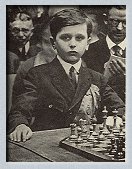Sammy Reshevsky
 The great Sammy Reshevsky was born in Poland in 1912. By the time Sammy was only eight years old, he toured the world to display his prowess as a child prodigy of chess, giving exhibitions in Europe and the United States.
The great Sammy Reshevsky was born in Poland in 1912. By the time Sammy was only eight years old, he toured the world to display his prowess as a child prodigy of chess, giving exhibitions in Europe and the United States.
To quote Reshevsky from his autobiography:
"Wherever I went, great crowds turned out to see me play. For four years, I was on public view. People stared at me, poked at me, tried to hug me, asked me questions. Professors measured my cranium and psycho-analyzed me. Reporters interviewed me and wrote fanciful stories about my future. Photographers were forever aiming their cameras at me. It was, of course, an unnatural life for a child, but it had its compensations and I cannot truthfully say that I did not enjoy it. There was the thrill of travelling from city to city with my family, the excitement of playing hundreds of games of chess and winning most of them, the knowledge that there was something "special" about the way I played chess, although I didn't know why."
-S. Reshevsky, Reshevsky on Chess, 1948
The Difference Between 8 and 36
"When I was a child touring Europe and the United States as a chess prodigy, my performances were the subject of much speculation. Everyone was curious to know "how an eight-year-old boy could beat gray beards at their own game." People continually pestered me for an explanation. I could not answer their questions then, nor can I do so now. Chess was, for me, a natural function, like breathing. It required no conscious effort. The correct moves in a game occurred to me as spontaneously as I drew breath. If you consider the difficulty you might have in accounting for that everyday action, you will have some inkling of my dilemma in trying to explain my chess ability.In 1924, at the age of 12, Reshevsky's parents stole him away from chess and he went to school for the first time of his life. A tutor helped him to graduate high school level, which Reshevsky had no problem doing. Reshevsky then went firstly to University of Detroit, and then to University of Chicago, where he obtained his degree in Mathematics in 1933.
Today, spectators feel another kind of astonishment. It is my practice to spend the major part of my allotted time on the first fifteen or twenty moves of a tournament game. As a consequence, I am often forced to play at breakneck speed to avoid overstepping the limit. After such a game, I am frequently asked why I took so long considering "obvious" moves. That's a question to which I am able to give a partial answer.
To a chess master, there is no such thing as an "obvious" move. Experience has shown repeatedly that wins or draws are thrown away by thoughtless play. Careful planning is the essence of chess strategy. Every move must be scrutinized with care. Each must be analyzed in the light of the plan under consideration. Nowhere is waste of time more severely punished than in chess."
To quote from his autobiography:
"While I was at school I played very little serious chess Ö Among musicians, it is a rule, rather than the exception, that the child prodigy of one generation is the mature artist of the next.In 1932, Reshevsky came in a tie for third in the tournament in Pasadena, California (my birthplace) and lost to the great World Chess Champion, Dr. Alexander Alekhine. In 1933, the mature 21-yr-old Reshevsky returned to serious chess for the first time after that loss.
There are fewer cases in chess. This much, however, is clear: if one decides to make chess a profession, a childhood devoted to the game cannot possibly be a handicap. In my own case, chess has always been the medium in which I feel most at home: at a chessboard I express myself in my mother tongue."
In 1934, after Reshevsky tied for first prize at the Western Championship at Chicago, he won first prize without a loss of a game in the International Tournament at Syracuse, NY. Here is when he earned the right to play in the tournament that contained Capablanca. In 1934 is where he beat the great, THE GREAT, Jose Capablanca, whose record is 416 wins, 19 losses in his career, at Margate, England. Reshevsky actually came first prize in the tournament.
If you add up all of his wins in the US Chess Championships, US Open Championships, Western Championships, and American Championships, no one else even comes close.
In the great 1936 Nottingham Tournament, Sammy was only ‡ point behind the lead. For years this was considered the greatest and strongest chess tournament in history.
He then dropped out of chess, but came back to win the US Chess Championship in 1938, and then skipped a year, and defended it in 1940. He then dropped out of chess again, but played GM Isaac Kashdan for the US Championship in 1942, which Reshevsky won.
Reshevsky played in the great 1951 Candidates Tournament that Bronstein won. In 1961 he played a drawn match against the most famous chess prodigy, Bobby Fischer. When he was almost 60 years old he qualified for the Inter Zonal at Mallorca and scored 9‡ points out of a possible 23. He even won a tournament in the 1990's in Iceland, before his death.

